Many people consume their food in a hasty and careless manner. This may result in weight gain and other health problems. Eating slowly may be a much wiser approach, as it may provide a number of advantages. This article discusses the advantages of eating slowly. Eating too quickly frequently results in overeating because your brain does not have enough time to detect fullness signals.
Chewing thoroughly aids digestion. Chewing has also been linked to a lower risk of obesity, possibly by increasing the thermic effect of food consumption. However, the factors underlying this heat-generating effect of chewing have received little attention. According to a new study, oral stimuli, which are associated with the duration of tasting liquid food in the mouth and the duration of chewing, play a positive role in increasing energy expenditure after food consumption.
It is common knowledge that chewing food thoroughly promotes a healthy eating habit. Slow eating and thorough chewing help prevent obesity and weight gain, according to a century-old belief that has since been tested in sporadic scientific studies. Typically, chewing increases the energy expenditure associated with food metabolism and increases intestinal motility, all of which adds up to an increase in heat generation in the body after food intake, known as diet-induced thermogenesis (DIT).
We discovered that DIT, or energy production, increased after eating a meal, and that it increased with the duration of each taste stimulation and chewing. This means that, regardless of the effect of the food bolus, oral stimuli such as the duration of tasting food in the mouth and the duration of chewing increased DIT.
Professor Naoyuki Hayashi
However, it is unclear how prolonged chewing causes DIT in the body. Dr. Yuka Hamada and Professor Naoyuki Hayashi of Waseda University in Japan recently published a study that establishes a link between chewing and DIT. The research was published in the journal Scientific Reports.
DIT, also known as the thermic effect of food consumption, raises energy expenditure above the basal fasting level – a factor that has been linked to weight loss. Previously, the researchers discovered that slowing down and chewing thoroughly not only increased DIT but also improved blood circulation in the splanchnic region of the abdomen. Although these studies linked chewing-induced-DIT to increased digestion and absorption-related activity in the abdomen, they left some important questions unanswered.
Hayashi elaborates, “We weren’t sure if the size of the food bolus that entered the digestive tract played a role in the increase in DIT observed after slow eating. Also, do oral stimuli produced by prolonged food chewing play a role in increasing DIT? We needed to delve deeper into these aspects in order to define slow chewing as an effective and scientific weight loss strategy.”

To find the answers, the researchers devised a new study that used liquid food to eliminate the effect of the food bolus. Three trials were conducted on different days as part of the overall study. In the control trial, volunteers were asked to swallow 20-mL liquid test food normally every 30 seconds. In the second trial, volunteers held the same test food in their mouth for 30 seconds without chewing, allowing them to taste it for a longer period of time before swallowing.
Finally, in the third trial, they looked at the effects of chewing and tasting; volunteers chewed the 20-mL test food for 30 seconds at a rate of once per second before swallowing it. Before and after the test-drink consumption, hunger and fullness, gas-exchange variables, DIT, and splanchnic circulation were all measured.
The findings of this well-designed study were quite insightful. The hunger and fullness scores did not differ between trials. However, as Hayashi points out, “We discovered that DIT, or energy production, increased after eating a meal, and that it increased with the duration of each taste stimulation and chewing. This means that, regardless of the effect of the food bolus, oral stimuli such as the duration of tasting food in the mouth and the duration of chewing increased DIT.”
Gas exchange and protein oxidation increased with the duration of taste stimulation and chewing, as did blood flow in the splanchnic celiac artery. Because this artery supplies blood to the digestive organs, the motility of the upper gastrointestinal tract increased in response to oral stimuli during chewing.
The study found that chewing properly can help prevent obesity and metabolic syndrome by increasing energy expenditure. “While the difference in energy expenditure per meal is small, the cumulative effect gathered over multiple meals, taken over every day and 365 days a year, is substantial,” Hayashi concludes.
Slow eating and thorough chewing, backed by solid science, could be the latest recommendations for incorporating into our weight-loss efforts.
















